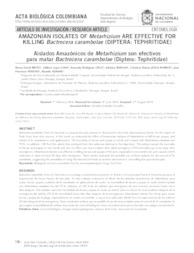Amazonian isolates of Metarhizium are effective for killing Bactrocera carambolae (Diptera: Tephritidae).
Amazonian isolates of Metarhizium are effective for killing Bactrocera carambolae (Diptera: Tephritidae).
Author(s): BRITO, B. D.; LIMA, A. L.; CRUZ, K. R.; BARIANI, A.; JESUS-BARROS, C. R. de; PEREIRA, J. F.; ADAIME, R.
Summary: Bactrocera carambolae Drew & Hancock is a quarantine pest present in Brazil and is the main phytosanitary barrier for the export of fresh fruits from that country. In this work, we evaluated the effect of Amazonian isolates of Metarhizium on kill larvae, pupae, and adults of B. carambolae in soil applications. The mortality of larvae and pupae in sterile soil treated with Metarhizium anisopliae was 70 %. In addition, 100 % of the adults that emerged from this substrate died up to five days later. This isolate caused the mortality of larvae and pupae in non-sterile soil, but its effect was more evident after adult emergence (70 % mortality up to ten days after emergence). Metarhizium robertsii was effective in killing larvae and pupae of the pest, especially in non-sterile soil, and caused a 60 % reduction in adult survival 50 days after emergence. These results indicated the possible use of these isolates for the control of B. carambolae, suggesting the possibility of using this biocontrol mode as another alternative in controlling this quarantine pest. Keywords: Biological control, carambola fruit fly, entomopathogenic fungi, fruit flies.
Publication year: 2019
Types of publication: Journal article
Unit: Embrapa Amapá
Observation
Some of Embrapa's publications are published as ePub files. To read them, use or download one of the following free software options to your computer or mobile device. Android: Google Play Books; IOS: iBooks; Windows and Linux: Calibre.
Access other publications
Access the Agricultural Research Database (BDPA) to consult Embrapa's full library collection and records.
Visit Embrapa Bookstore to purchase books and other publications sold by Embrapa.

